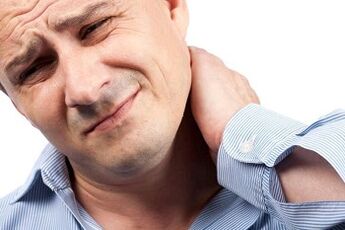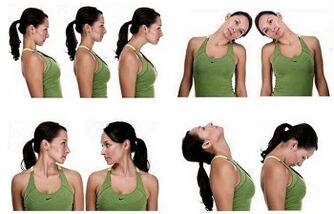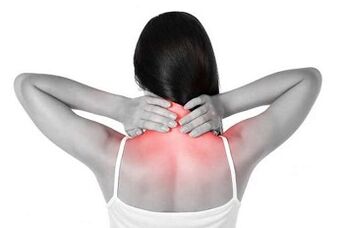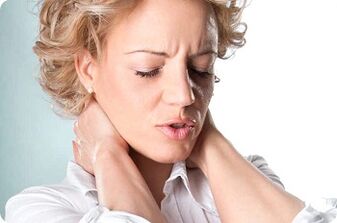
The tendency to cultivate degenerative lesions of the spine is constantly growing every year, and everything is because the problem of hypodinamia and hypocinesia is acute due to urbanization.The damage to the cervical column causes frequent, various intensities of headaches and a sensation of stiffness in the neck and forearms.Today our theme is the causes, symptoms and treatment of osteochondrosis of the cervical region.
The reasons for the development of cervical osteochondrosis
Speaking about the causes of degenerative damage to the cervical column, genetics, toxic, metabolic, endocrine, infectious and others can be listed.However, in the first place, you can put a sedentary lifestyle and sit on the computer, desk and driving.
The frequent tensions that involuntarily make a Stoop posture, which leads to the infringement of blood vessels in the nerve neck, help help this pathology.
The symptoms of neck pain should not be ignored, since this leads to the progression of the disease and to the development of complications such as shoulder periarrosis, the vertebral artery syndrome, the anterior staircase syndrome and the syndrome of the realization of the realization.
About the anatomical structure
Now let's see what anatomical and physiological characteristics of the structure of the cervical column contribute to the development and progression of osteochondrosis:
- The department of Cervical is the most mobile section of the spinal column.Since all types of movements are possible in it, this increases the risk of subluxation and frequent infractions;
- The vertebral artery takes place in the channel formed in the holes of the cross processes of the vertebrae.It is the custom of the brain, the auditory organs, the spinal nerve and the cerebellum.With the development of Degenerative-Distrophic Changes, the artery and nerve can hold in this department.
- In the cervical region, intervertebral discs are not everywhere among the vertebrae.In the front, the vertebrae are connected by joints, which can cause the subluxation of the joints.
- The holes in the three lower cervical vertebrae have a triangular shape, and with the growth of bone tissue with osteochondrosis, nerve roots can violate.
- Throughout the department of Cervical, there are plant ganglia.
These characteristics will help us present the mechanism for the development of complications of the osteochondrosis of the cervical column.
Mechanisms for the development of changes in the cervical column

The pathological process begins on the intervertebral disc with the loss of moisture with an octopoose disc core.The fibrous ring of the album is becoming thinner, its elasticity decreases and microwave appears.
As a result, the album loses its ability to fix, depreciation and support.The load in the lower vertebrae increases gradually, after which the vertebra itself is involved in the process.
Small defects appear in it and osteophytes (excessive bone growth) are growing to resist an augmented load.
With the growth of bone tissue, nerve roots are squeezed along the posterior wall of the vertebra, and if the vertebral artery is violated on the lateral surface.
Sub -Luis in the joints appear due to a violation of stability between the vertebrae.This leads to a compensatory voltage of neck muscles, which helps maintain cervical vertebrae in a normal position.
When the muscles get tired, the load in the vertebrae increases again, which leads to the progression of the disease.Therefore, a vicious circle is formed in which spasmodic muscles and damaged vertebrae are negatively affected and lead to deterioration in the patient's condition.
Based on pathological mechanisms, disease symptoms are formed.Then, squeezing nerve roots is manifested by intense paroxysmal pain along the infringed nerve.
And when compressing the vertebral artery, the symptoms associated with a decrease in blood flow in the brain, namely: noise in the ears, dizziness and headache, they appear first.
The main symptoms of cervical osteochondrosis.
The main symptoms of cervical osteochondrosis are conditionally divided into 3 groups:
The first group of symptoms: pain
It manifests itself in the form:
- local pain on the back of the head/neck;
- The irradiated pain, which extends to the right or left hand, and can also go to the fingers, to the brush, to the forearm and even locate in the shoulder joints.
This pain can be painful and constant, irritating and extended by the neck or hand.Or it is a more acute local shooting pain that appears as a result of the pinch of the nerve root.
The second group of symptoms are motor disorders
First, it is the rigidity of the neck and neck muscles, as a result of which it is impossible to turn or incline the head normally, or make any movement in the cervical column.
In addition, this is a limitation of the mobility in the shoulder joint, which is called the peeling peel syndrome.It is also possible to extend to the whole hand, including fingertips of the fingers, numbness of the hands and numbness along the side of the lateral surface of the shoulder or the forearm.
The third group of symptoms are vegetating manifestations, the manifestations of the vessels
In the process of this, there is a spasm of blood vessels or pinching in the spine.As a result, such symptoms of cervical osteochondrosis can appear as headaches, dizziness, flickering "flies" in front of the eyes.
There may also be hearing impairment: noise in the ears and the feeling of a "sulfur cap", in which a person does not listen well.These symptoms belong to the vertebral artery syndrome.
Traditional treatment methods of cervical osteochondrosis

Modern medicine offers many methods to treat degenerative-dystophical lesions of the spine.Among them, they distinguish: pharmacological treatment, manual therapy, popular remedies, therapeutic physical culture (exercise therapy) and in long -functioning cases resort to surgical treatment.The effectiveness of therapy depends on which stage the treatment and a complex of selected methods have begun.
The treatment should be aimed at normalizing the muscle tone of cervical muscles.The action of other media aims to eliminate inflammation and pain in the field of development of pathological changes.
An important point in the treatment of osteochondrosis is a good comfortable dream, for which experts recommend using an orthopedic pillow.
In the early stages of the development of the disease, the use of massages in an experienced specialist and auto -Masog will be effective.This method will help relax spasmodic muscles and stop the progression of the pathological process.
Medical Physical Education
The treatment of osteochondrosis should include physiotherapy exercises in the form of therapy or morning hygienic gymnastics.When carrying out a complex of treatment exercises, adhere to the following recommendations:
- Put comfortable clothes and shoes;
- so that there is no shortage of lack of breath, alternative exercises of ordinary breathing;
- The load must increase gradually, and if during the lesson the complaints of the cardiovascular system began to mark, then stop the exercise and seek advice to the doctor;
- If the pain appeared in the cervical column during the lesson, replace them with relaxation and stretching exercises;
- During the lesson, control your general well, breathing and pulse;
- If the exercises with the hand and the load cause you to pronounce pain, then for a while, abandon them;
- The physical exercises complex of therapeutic exercises must be agreed with the doctor.

The following effects of physiotherapy exercises are expected:
- Strengthen neck muscles,
- Restoration of blood flow;
- Greater mobility of the vertebrae;
- Increase the volume of movements in the cervical region;
- Get rid of pain and restoration of innervation;
- Exacerbations prevention.
Drug treatment
Most neuropathologists and other experts do not represent the treatment of the osteochondrosis of the cervical column without medications.The most popular are the drugs of a group of non -steroid anti -inflammatory drugs (NSAIDs), which are used in the form of injections, tablets, gels and ointments.
Non -steroidal anti -inflammatory medications relieve pain, inflammation and swelling relief, as a result, the tone of the neck muscles is restored, improves metabolism in the affected area, and nerve roots and blood vessels are released from compression.
It is advisable to use drugs from a group of muscle relaxants, who also effectively relieve muscle spasm and at the same time restore their tone.However, drugs should be used with caution, especially in allergies.

The preparations for the corticosteroid group have obtained good reviews in the treatment of the osteochondrosis of the cervical column.
The injection drug is very popular due to its anti -inflammatory and neuroprotective effects.
If the treatment described is not effective, then they resort to the use of the paravertebral block with analgesics or steroids.
How to treat cervical osteochondrosis with non -traditional methods
Supporters of non -traditional treatment methods can use the following treatment methods.
- AcupunctureIt helps to save the patient from pain, relieve swelling and relax spasmodic muscles, as well as eliminate the functional squeeze of nerves and arteries.If the fingers are numb in the hands, it is advisable to place the needles in biologically active points in the arm sink and the ear;
- Manual therapyIt helps restore normal blood flow in the neck, relieves muscle spasm and releases pinched nerves.Stretching the column must be performed by an expert specialist with great caution;
- Hirudotherapy (Sanguijuela treatment)It is a method of economic and quite effective treatment.The procedure is to place leeches for biologically active points, which must be repeated in a course of 10 sessions.This method helps restore blood circulation in the cervical region, relieve swelling and inflammation;
- Supreme massageIt consists of the effects of the finger in biologically active points and helps relieve muscle spasm, improve blood circulation, relieve swelling, pain and inflammation;
- Popular treatment methodsYou can use it successfully at home.These are several decoctions and infusions that can be prepared by yourself (adjustment infusion, lilac infusion, garlic infusion).Therapeutic baths made of mint, chamomile, sage, Rizomas de Calamus have a good effect.

After the previous methods of treatment and familiarization with the mechanisms of the development of the disease, make a decision with which you communicate with your problem: to a neuropathologist or private clinic.



















































